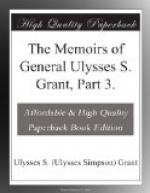On leaving Bruinsburg for the front I left my son Frederick, who had joined me a few weeks before, on board one of the gunboats asleep, and hoped to get away without him until after Grand Gulf should fall into our hands; but on waking up he learned that I had gone, and being guided by the sound of the battle raging at Thompson’s Hill—called the Battle of Port Gibson—found his way to where I was. He had no horse to ride at the time, and I had no facilities for even preparing a meal. He, therefore, foraged around the best he could until we reached Grand Gulf. Mr. C. A. Dana, then an officer of the War Department, accompanied me on the Vicksburg campaign and through a portion of the siege. He was in the same situation as Fred so far as transportation and mess arrangements were concerned. The first time I call to mind seeing either of them, after the battle, they were mounted on two enormous horses, grown white from age, each equipped with dilapidated saddles and bridles.
Our trains arrived a few days later, after which we were all perfectly equipped.
My son accompanied me throughout the campaign and siege, and caused no anxiety either to me or to his mother, who was at home. He looked out for himself and was in every battle of the campaign. His age, then not quite thirteen, enabled him to take in all he saw, and to retain a recollection of it that would not be possible in more mature years.
When the movement from Bruinsburg commenced we were without a wagon train. The train still west of the Mississippi was carried around with proper escort, by a circuitous route from Milliken’s Bend to Hard Times seventy or more miles below, and did not get up for some days after the battle of Port Gibson. My own horses, headquarters’ transportation, servants, mess chest, and everything except what I had on, was with this train. General A. J. Smith happened to have an extra horse at Bruinsburg which I borrowed, with a saddle-tree without upholstering further than stirrups. I had no other for nearly a week.




